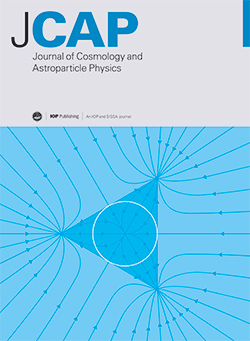Energy extraction from Loop Quantum Black Holes: the role of magnetic Penrose process and quantum gravity effects with astrophysical insights
IF 5.3
2区 物理与天体物理
Q1 ASTRONOMY & ASTROPHYSICS
Journal of Cosmology and Astroparticle Physics
Pub Date : 2025-03-21
DOI:10.1088/1475-7516/2025/03/053
引用次数: 0
Abstract
In this study, we explore the influence of quantum gravitational corrections, derived from Loop Quantum Gravity (LQG), on the efficiency of the magnetic Penrose process (MPP) in black hole (BH) environments. We begin by analyzing the rotating Loop Quantum Black Hole (LQBH) metric, describing the structure of the event horizon and ergosphere as functions of the quantum parameter ϵ = γδ, with γ representing the Immirzi parameter and δ the polymeric parameter, and the spin parameter a. These modifications provide a novel setting for exploring the dynamics of charged particles near the LQBH and evaluating the resultant energy extraction through the MPP. Interestingly, for a given value of the LQBH parameter a, we observe that the ergosphere region of the LQBH exhibits a more intricate structure compared to its classical counterpart, the Kerr BH, as ϵ increases. Furthermore, we find that the overall efficiency of the process decreases with ϵ that decreases amax, again in contrast to the Kerr BH, where efficiency rises with an increasing a. Our analysis also extends to astrophysical contexts, applying constraints on the mass and magnetic field of LQBHs for astrophysical BH candidates, including Sgr A*, M87*, NGC 1052, and BZ (Blandford and Znajek sources, i.e., supermassive BHs with masses around 109M⊙ and magnetic fields in the range 103-104G). We assess these sources as potential accelerators of high-energy protons across different values of the quantum parameter ϵ. Additionally, we examine how variations in the magnetic field strength B and quantum corrections impact the energy of protons accelerated from M87★ and Sgr A★ following beta decay. Finally, the results reveal potential observational signatures of LQG and insights into quantum gravity's role in high-energy astrophysics.从环状量子黑洞提取能量:彭罗斯磁过程的作用和量子引力效应与天体物理学启示
本文章由计算机程序翻译,如有差异,请以英文原文为准。
求助全文
约1分钟内获得全文
求助全文
来源期刊

Journal of Cosmology and Astroparticle Physics
地学天文-天文与天体物理
CiteScore
10.20
自引率
23.40%
发文量
632
审稿时长
1 months
期刊介绍:
Journal of Cosmology and Astroparticle Physics (JCAP) encompasses theoretical, observational and experimental areas as well as computation and simulation. The journal covers the latest developments in the theory of all fundamental interactions and their cosmological implications (e.g. M-theory and cosmology, brane cosmology). JCAP''s coverage also includes topics such as formation, dynamics and clustering of galaxies, pre-galactic star formation, x-ray astronomy, radio astronomy, gravitational lensing, active galactic nuclei, intergalactic and interstellar matter.
 求助内容:
求助内容: 应助结果提醒方式:
应助结果提醒方式:


